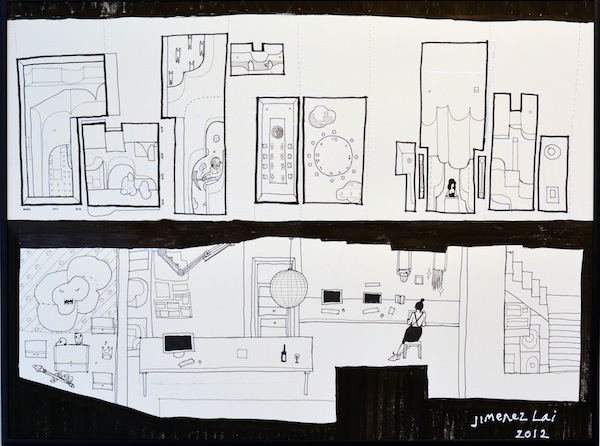The Sheepdogs should bring warm feelings of Woodstock to Randall’s Island when they play the Catalpa Festival on Saturday afternoon. The bluesy psychedelic rockers, who hail from Saskatoon, Canada, know how to keep on choogling with their rollicking good-time music, as they’ve shown on such records as 2007’s Trying to Grow and 2010’s Learn & Burn and an exhausting touring schedule. But singer-guitarist Ewan Currie, guitarist Leot Hanson, bassist Ryan Gullen, and drummer Sam Corbett, LP lovers all, took a giant leap forward last summer when they were voted onto the cover of Rolling Stone, the first unsigned band to achieve that honor. The victory came with an Atlantic Records contract; their eponymous major-label debut is set for release September 4, but the first song, “The Way It Is,” is available now. The Sheepdogs will be taking over the 2nd Stage at Catalpa at 5:00 on July 28, following the Demos and before Umphrey’s McGee. For an interview with the festival’s founder, Dave Foran, go here.
Yearly Archives: 2012
CHRISTIAN JANKOWSKI: DISCOURSE NEWS
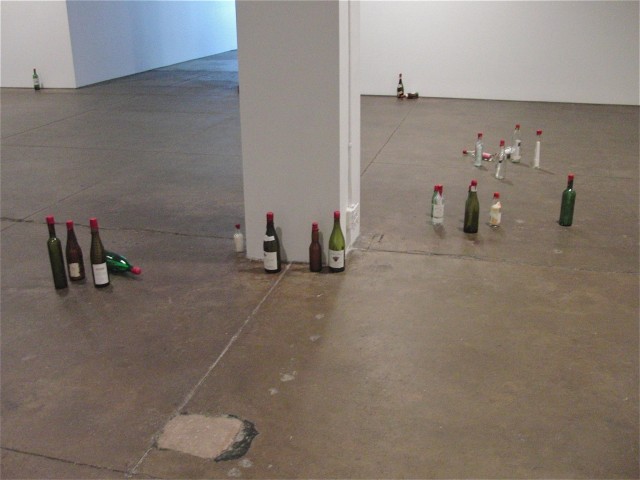
One of these bottles in Christian Jankowski exhibit at Friedrich Petzel Gallery could have been ours (photo by twi-ny/mdr)
Friedrich Petzel Gallery
537 West 22nd St. between Tenth & Eleventh Aves.
Through July 27, free, 10:00 am – 6:00 pm
212-680-9467
www.petzel.com
Back in April, we received several e-mails about Christian Jankowski’s upcoming exhibition at Friedrich Petzel Gallery in Chelsea. Thinking it was just the usual series of press releases, we filed them away, to be revisited once the show began and we checked it out. We really wish we had paid more attention back then, because they turned out to be invitations to actually be part of the multimedia show. The Berlin-based Jankowski specializes in work that explores the meta surrounding the art world, resulting in multidimensional installations that are as much about the work itself as they are works of art on their own. The show at Friedrich Petzel contains four distinct elements that combine to give viewers a fascinating look into Jankowski’s unique creative process. As you enter the gallery, you are met by a flatscreen monitor hanging from the ceiling, depicting NY1 Senior Business Anchor Annika Pergament giving a fake report about Jankowski’s latest installation, the very “Discourse News” that you are watching. Pergament talks with so-called experts about Jankowski and his oeuvre while highlighting such questions as “Why is the artist so obsessed with the discourse?” It’s so professionally done that it’s difficult to determine what’s real and what’s staged, but what really makes it so riveting — and so entertaining — is that it lets visitors in on the inside joke from the very start. Meanwhile, to the left behind the reception desk, the words “Please Stop You’re Boring Me to Death” are written out in white neon along with a drawing of two people, taken from something a visitor wrote in a gallery sign-in book, as Jankowski once again creates a work of art about something someone else said about a work of art. “Review,” the piece we were invited to be part of, consists of dozens of handwritten advance reviews that “renowned art critics” rolled up and placed in sealed glass and plastic bottles, then sent to Jankowski, who has scattered them across the gallery’s main space, where the pre-reviews tantalize visitors since the writings will never be read, as opposed to our review that you’re reading now and cannot be rolled up and stored away forever, sight unseen, within a sealed bottle. The show concludes with the forty-seven-minute black-and-white video The Eye of Dubai, in which a blindfolded Jankowski — and his blindfolded crew — make their way through Dubai led by local artist Rami Farook and followed by BBC World News, which is preparing a Collaboration Culture documentary about the project, the meta becoming an integral part of the discourse. Just the idea of an artist walking around blind in the massively growing international city that now hosts a highly touted art fair invites plenty of discourse on its own, but including the BBC doing a story on it takes it to the next level. Jankowski, whose ”Living Sculptures: Caesar, Dali Woman, El Che” was installed in the Doris C. Freedman Plaza entrance to Central Park in 2008-2009, also currently has a piece in the Public Art Fund’s “Common Ground” group show in City Hall Park, a granite grave stone that says, “Christian Jankowski 1968- Buried Somewhere on Common Ground in City Hall Park,” because in Jankowski’s world, even the eventual death of the artist can be a work of art worthy of further commentary.
CATALPA VIDEO OF THE DAY: “SEEKIR” BY ZOLA JESUS
Singer-songwriter Nika Roza Danilova, better known as the one-woman recording phenomenon Zola Jesus, continues her reign as the alterna–Stevie Nicks on her third album, Conatus (Sacred Bones, October 2011), the follow-up to her 2010 sophomore full-length, Stridulum II. The twenty-three-year-old, who was born and raised on a large farm in Wisconsin, favors long, flowing blonde hair that meshes with her long, flowing white outfits, both supplying a stark contrast to her haunting electro-Goth music. On Conatus, she takes listeners on a dark, introspective journey into the fear that pervades her soul, filled with repeated images of fire. “Oh, it hurts to let you in,” she sings on “Collapse.” On “Seekir” she asks, “Is there nothing left / of this mess we made? / Is there nothing left / of the love I gave?” On tour she is joined by a backing band that ably captures her unique sound, whether at CMJ or in the Guggenheim rotunda, where she performed this past May. Zola Jesus will be at the Catalpa Festival on Saturday, sharing an impressive bill with Hercules and Love Affair, Umphrey’s McGee, TV on the Radio, headliners the Black Keys, and others. The two-day festival continues on Sunday with Snoop Dogg, Girl Talk, Matt and Kim, Matisyahu, and more. For an interview with the festival’s founder, Dave Foran, go here.
RIVER FLICKS FOR GROWN-UPS: BRIDESMAIDS
BRIDESMAIDS (Paul Feig, 2011)
Hudson River Park, Pier 63 at 23rd St.
Wednesday, July 25, free, dusk
www.bridesmaidsmovie.com
www.riverflicks.com
 First and foremost, don’t link Bridesmaids in with all those lousy Saturday Night Live one-note movies and the string of overrated and overhyped lowbrow trash streaming out of the Judd Apatow factory. And don’t assume it’s a silly chick flick either. As it turns out, Bridesmaids is one of the most consistently funny laugh-out-loud romps of this young century. Directed by Freaks and Geeks creator Paul Feig, Bridesmaids is an endlessly clever and insightful examination of love, loneliness, and friendship starring SNL’s Kristen Wiig, who cowrote the smart script with Groundlings member Annie Mumolo (who makes a cameo as a nervous flyer). Wiig shows surprising depth and range as Annie, a perennial screw-up whose closest childhood friend, Lillian (Maya Rudolph), is marrying into a very snooty upper-crust family. After agreeing to be Lillian’s maid of honor, Annie gets involved in a battle of wits with Lillian’s future sister-in-law, the elegant Helen (a radiant Rose Byrne), who is determined to outshine Annie in every way possible and steal Lillian away from her. Already a mess — she had to close her bakery, she shares an apartment with a bizarre pair of British siblings, she works in a jewelry store where she drives away potential customers with her sorry tales of woe, and she allows herself to be treated miserably as a late-night booty call for a self-centered businessman (Jon Hamm) — Annie experiences a series of hysterical, pathetic setbacks as she attempts to organize the bridal shower and bachelorette party, including a riotous potty-humor scene in a high-end boutique that is likely to go down in comedy history for its sheer relentlessness. The rest of the bridesmaids are quite a hoot — Becca (Ellie Kemper), the Disney-loving kewpie doll; Rita (Wendi McLendon-Covey), a foul-mouthed married mother who can’t wait to go crazy away from her family; and the groom’s burly sister, Megan (the hugely entertaining Melissa McCarthy), who lives life without a filter. Annie is so caught up in her own failures that she doesn’t recognize when something potentially good enters her life, in the form of state trooper Nathan Rhodes (Chris O’Dowd). Wiig gives the finest performance of her career as Annie, clearly a role that is very close to her heart. Despite the slapstick nature of many of the jokes, Bridesmaids is filled with heart and soul, making it one of the best comedies in years. Bridesmaids is screening July 25 at Hudson River Park’s Pier 63 as part of the free River Flicks for Grown-Ups series, which continues through August 22 with such films as Limitless, Cowboys & Aliens, Crazy, Stupid Love, and Horrible Bosses. For a day-by-day listing of free summer movie screenings in New York City, go here.
First and foremost, don’t link Bridesmaids in with all those lousy Saturday Night Live one-note movies and the string of overrated and overhyped lowbrow trash streaming out of the Judd Apatow factory. And don’t assume it’s a silly chick flick either. As it turns out, Bridesmaids is one of the most consistently funny laugh-out-loud romps of this young century. Directed by Freaks and Geeks creator Paul Feig, Bridesmaids is an endlessly clever and insightful examination of love, loneliness, and friendship starring SNL’s Kristen Wiig, who cowrote the smart script with Groundlings member Annie Mumolo (who makes a cameo as a nervous flyer). Wiig shows surprising depth and range as Annie, a perennial screw-up whose closest childhood friend, Lillian (Maya Rudolph), is marrying into a very snooty upper-crust family. After agreeing to be Lillian’s maid of honor, Annie gets involved in a battle of wits with Lillian’s future sister-in-law, the elegant Helen (a radiant Rose Byrne), who is determined to outshine Annie in every way possible and steal Lillian away from her. Already a mess — she had to close her bakery, she shares an apartment with a bizarre pair of British siblings, she works in a jewelry store where she drives away potential customers with her sorry tales of woe, and she allows herself to be treated miserably as a late-night booty call for a self-centered businessman (Jon Hamm) — Annie experiences a series of hysterical, pathetic setbacks as she attempts to organize the bridal shower and bachelorette party, including a riotous potty-humor scene in a high-end boutique that is likely to go down in comedy history for its sheer relentlessness. The rest of the bridesmaids are quite a hoot — Becca (Ellie Kemper), the Disney-loving kewpie doll; Rita (Wendi McLendon-Covey), a foul-mouthed married mother who can’t wait to go crazy away from her family; and the groom’s burly sister, Megan (the hugely entertaining Melissa McCarthy), who lives life without a filter. Annie is so caught up in her own failures that she doesn’t recognize when something potentially good enters her life, in the form of state trooper Nathan Rhodes (Chris O’Dowd). Wiig gives the finest performance of her career as Annie, clearly a role that is very close to her heart. Despite the slapstick nature of many of the jokes, Bridesmaids is filled with heart and soul, making it one of the best comedies in years. Bridesmaids is screening July 25 at Hudson River Park’s Pier 63 as part of the free River Flicks for Grown-Ups series, which continues through August 22 with such films as Limitless, Cowboys & Aliens, Crazy, Stupid Love, and Horrible Bosses. For a day-by-day listing of free summer movie screenings in New York City, go here.
SLOWGIRL
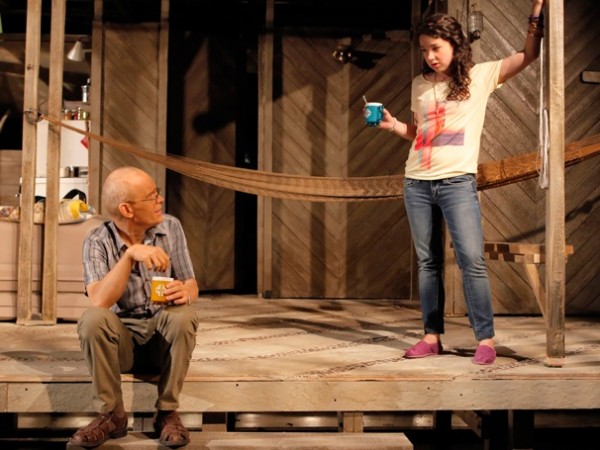
Željko Ivanek and Sarah Steele make a powerful team in Greg Pierce’s beautifully done SLOWGIRL (photo by Erin Baiano)
Claire Tow Theater
LCT3/Lincoln Center Theater
150 West 65th St.
Extended through August 5, $20
www.lct.org
Lincoln Center has inaugurated its new low-price, 112-seat Claire Tow Theater, which sits above the Vivian Beaumont and Mitzi E. Newhouse, with the world premiere of Greg Pierce’s wonderful two-character Slowgirl. After being blamed for a high school tragedy back home, seventeen-year-old Becky (Sarah Steele) is sent off to spend a few days with her reclusive uncle Sterling (Željko Ivanek), a divorced lawyer who has been living by himself in a shack in the jungles of Costa Rica for nine years. Whereas Becky is outgoing and seems to never be able to shut up and relax, Sterling chooses his words far more carefully, as if each one pains him to say out loud, while wincing at Becky’s openness and questionable language. The two very different people eventually bond over smoothies and iguanas as Becky talks about what happened to her somewhat off classmate known as Slowgirl, who was seriously injured at a graduation party, and Sterling discusses the events that ultimately led him into the jungle.
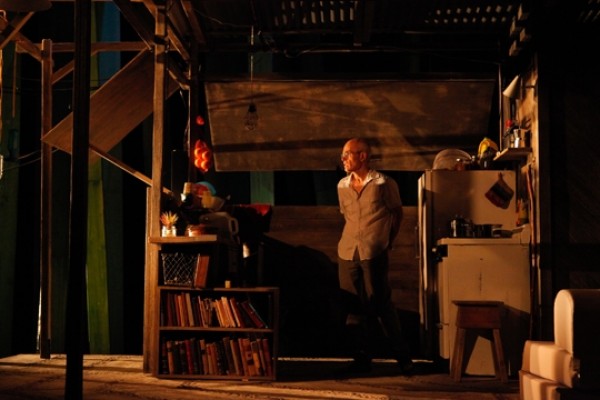
The reclusive Sterling (Željko Ivanek) is forced to face some dark secrets in SLOWGIRL (photo by Erin Baiano)
Emmy winner and multiple Tony nominee Ivanek, most well known for recurring roles on such television series as Homicide, Damages, and Oz in addition to stage appearances in such shows as The Caine Mutiny Court-Martial and Brighton Beach Memoirs, is mesmerizing as Sterling, a pent-up bundle of nerves who can barely get the words out of his mouth, while Steele (All-American, Russian Transport) is delightful as Becky, a fast-talking teen with no filter, spitting out whatever’s on her mind. Rachel Hauck’s main set, Sterling’s open-air shack, rises at one point to reveal a labyrinth Sterling built to help him silently concentrate and focus, something Becky seems incapable of doing. Leah Gelpe’s sound design includes animal and bird noises that make the audience feel like they’re in the middle of the jungle, while Anne Kauffman’s (This Wide Night, Thugs) direction seamlessly weaves the characters and story together. Pierce (The Wind-Up Bird Chronicle) has written a compelling, intelligent, splendidly nuanced hundred-minute drama that is filled with small surprises and little touches that serve as a terrific introduction to Lincoln Center’s intimate new theater, which is dedicated to works by emerging playwrights, directors, and designers, with tickets for all productions only $20.
PERFORMING REPRESENTATIONS
Storefront for Art and Architecture
97 Kenmare St.
Tuesday, July 24, free, 7:00
212-431-5795
www.storefrontnews.org
As part of the book launch for Jimenez Lai’s Citizens of No Place: An Architectural Graphic Novel (Princeton Architectural Press, May 2012, $19.95), the Storefront for Art and Architecture is hosting a special one-day-only exquisite-corpse drawing conversation with Lai, Drawing Center executive director Brett Littman, and architects Johanna Meyer-Grohbrügge and Michael Young. “Citizens of No Place imagines alternate worlds and engages with the design of architecture through the act of storytelling,” the book’s preface explains. “It offers narratives about character development, through which the reader can explore relationships, curiosities, and attitudes, as well as absurd stories about fake realities that invite new futures to become possibilities.” While discussing representation, the participants will create a continuous drawing, in conjunction with the Storefront’s current exhibition, “Aesthetics/Anesthetics,” which explores the nature of architectural drawings, with works by Lai, Vito Acconci, Sam Jacob, Philippe Rahm, Juergen Mayer H., Jorge Otero-Pailos, Noura Al Sayeh, Sho Shigematsu, Ling Fan, and others.
BILL BOLLINGER: THE RETROSPECTIVE
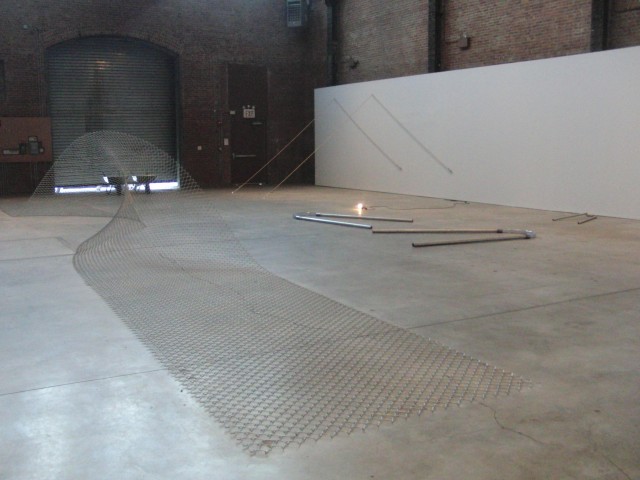
Extremely satisfying and necessary Bill Bollinger retrospective runs through July 30 at SculptureCenter (photo by twi-ny/mdr)
SculptureCenter
44-19 Purves St., Long Island City
Thursday – Monday through July 30, $5, 11:00 am – 6:00 pm
718-361-1750
sculpture-center.org
bill bollinger slideshow
“I only do what it is necessary to do,” Brooklyn-born sculptor Bill Bollinger said in 1968. “There is no reason to use color, to polish, to bend, to weld, if it is not necessary to do so.” Bollinger, who died of alcoholism in 1988 at the age of forty-eight, is the subject of a small but fascinating retrospective at SculptureCenter in Long Island City. Concentrating on his most productive years of the late 1960s, the two-floor show consists of many works that repurpose standard industrial supplies, emphasizing space, form, and materiality. Using wheelbarrows, lightbulbs, Manila rope, plastic hoses, electric cables, aluminum pipes, and sections of Cyclone fencing, Bollinger created a conceptual oeuvre that brought together art and commodity in unique ways; indeed, sometimes you have to look twice before realizing what is part of the show and what is merely part of SculptureCenter’s former-factory home. But that is not meant to detract one iota from Bollinger’s extremely satisfying work, particularly “Cyclone Fence,” a gently, beautifully twisted chain-link fence that rises from the floor as if it’s alive, and “Graphite Piece,” in which black graphite powder has been thrown against a wall in its own room. A contemporary of such more well known artists as Richard Serra, Eva Hesse, Bruce Nauman, Dan Flavin, Carl Andre, Donald Judd, and Robert Smithson, Bollinger participated in several important and influential group shows in the late 1960s, as well as having his own solo exhibition at the Starrett-Lehigh Building in 1970, before personal problems, including a custody battle for his son that he ultimately won, sent him upstate into relative obscurity. The show is supplemented with a series of drawings upstairs as well as preparatory sketches, notes, and letters downstairs that reveal Bollinger’s detailed creative process. The retrospective also includes Bollinger’s only known film, in which he tries to balance what appears to be a telephone pole on the ground, only to knock it over once he does so, toying with the viewer’s expectations. “It is all very easy to execute, does not exist until it has been executed, ceases to exist when it has been taken down,” he once explained. “Bill Bollinger: The Retrospective” offers a much-needed, well-curated look at an important twentieth-century artist whose history had been threatening to cease to exist.

